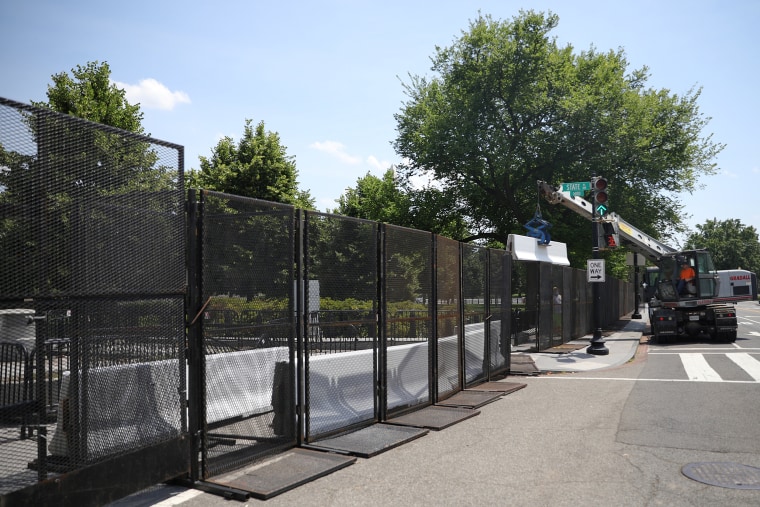WASHINGTON — After another night of peaceful protests outside of Lafayette Square Wednesday, workers were seen putting up new fencing barriers around the White House complex Thursday morning, adding to the 8-foot fence that was erected around the entrance to Lafayette Square earlier in the week.
Reporters arriving at the White House as early as 5:30 a.m. ET on Thursday morning described seeing black fences being put up along the Eisenhower Executive Office Building entrance on 17th St. NW.
By the afternoon, the new fencing could be seen stretching from the back of the White House complex, closing off the entrance to The Ellipse and stretching all the way up 17th St., blocking off the Eisenhower Executive Office Building.
The additional fencing did not have the same slightly sharper edges at the top as the one blocking off the entrance to Lafayette Square, where the majority of the protests have taken place.
It is unclear why the White House felt the need for additional fencing. Although protests over the weekend in response to George Floyd’s death became violent at times, demonstrations have been peaceful since Monday when police forcibly removed peaceful protesters from the Lafayette Square area using rubber bullets, smoke bombs and pepper balls so that Trump could take a photo in front of St. John's Episcopal Church.
“The White House does not comment on security protocols and decisions," said White House spokesperson Judd Deere when asked about the new fencing.
The Secret Service said "the closures are in an effort to maintain the necessary security measures surrounding the White House complex, while also allowing for peaceful demonstration," adding that the closed off areas would remain blocked until June 10.
The additional security could be in preparation for Saturday, when another large protest is expected to take place in Washington. Secret Service took Trump to the underground bunker at the White House Friday night, as protests outside the building intensified.
Still, D.C. police chief Peter Newsham did not think that there was cause for alarm.
"These large, extremely large, peaceful protests is something we feel very comfortable managing," Newsham said Thursday. "If you look at the way that this particular event has moved forward, we've had a couple of days of really good, successful peaceful demonstrations and moving forward that's what I expect regardless of size."
The new fencing prompted many people on social media to joke that Trump was finally getting his wall, a reference to his 2016 campaign promise to construct a wall along the U.S.-Mexico border.
Trump frequently talks about the “beautiful border wall” and has promised to complete more than 500 miles by the end of his first term. It is unlikely the president will meet that goal as he has struggled to received funding from Congress and has run into multiple legal issues trying to acquire private land along the Texas border.
“If Trump erected more than 3 miles of fence around the White House, it would exceed the length of his new wall on the southern border,” tweeted Anthony Scaramucci, who served as Trump’s communications director for a little more than a week in 2017. “His bigotry is only exceeded by his incompetence.”
Others said that the new fencing was a "sad commentary" of Trump’s presidency and how he has handled the protests.
“I am one of those people who grew up in Washington, D.C., and has been very accustomed to having access to all of our federal facilities,” said Washington Mayor Muriel Bowser at a press conference Thursday, adding that she was “concerned" that some of the fencing was “not just temporary.”
“Keep in mind that that's the Peoples’ House. It's a sad commentary that the House and its inhabitants have to be walled off. I think that that's a sad commentary. We should want the White House to be opened up for people to be able to access it from all sides," she continued.
The section of Pennsylvania Avenue right in front of the White House is typically closed to cars and open to pedestrians year-round, with occasional closures for maintenance or presidential movements. Lafayette Square, the park in front of the White House, is also open to the public and is rarely closed.
"Those are federal assets, true," Bowser said. "But they are also very important to local Washington and to our country and so people need to have access to our public buildings."

